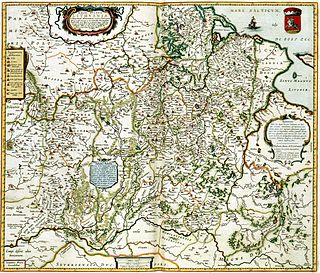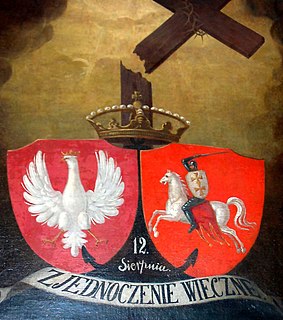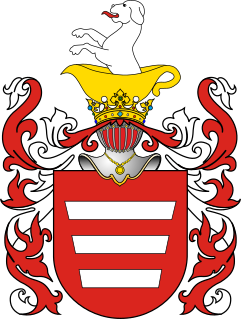 W
WThe history of Lithuania between 1219 and 1295 concerns the establishment and early history of the first Lithuanian state, the Grand Duchy of Lithuania. The beginning of the 13th century marks the end of the prehistory of Lithuania. From this point on the history of Lithuania is recorded in chronicles, treaties, and other written documents. In 1219, 21 Lithuanian dukes signed a peace treaty with Galicia–Volhynia. This event is widely accepted as the first proof that the Baltic tribes were uniting and consolidating. Despite continuous warfare with two Christian orders, the Livonian Order and the Teutonic Knights, the Grand Duchy of Lithuania was established and gained some control over the lands of Black Ruthenia, Polatsk, Minsk, and other territories east of modern-day Lithuania that had become weak and vulnerable after the collapse of Kievan Rus'.
 W
WThe Polish–Lithuanian Union was a relationship created by a series of acts and alliances between the Crown of the Kingdom of Poland and the Grand Duchy of Lithuania that lasted for prolonged periods of time from 1385 and led to the creation of the Polish–Lithuanian Commonwealth - the "Republic of the Two Nations" - in 1569 and eventually to the creation of a unitary state in 1791.
 W
WThe Duchy of Lithuania was a state-territorial formation of ethnic Lithuanians which existed from the 13th century to 1413. For most of its existence, it was a constituent part and a nucleus of the Grand Duchy of Lithuania. Other alternative names of the territorial formation, used in different periods, were Aukštaitija or Land of Lithuania, Duchy of Vilnius, Lithuania proper or simply Lithuania.
 W
WThe rule of the Jagiellonian dynasty in Poland between 1386 and 1572 spans the late Middle Ages and early Modern Era in European history. The dynasty was founded by the Lithuanian Grand Duke Jogaila, whose marriage to Queen Jadwiga of Poland formed a Polish–Lithuanian union. The partnership brought vast territories controlled by the Grand Duchy of Lithuania into Poland's sphere of influence and proved beneficial for both the Polish and Lithuanian people, who coexisted and cooperated in one of the largest political entities in Europe for the next four centuries.
 W
WThe Jagiellonian dynasty was a royal dynasty, founded by Jogaila, the Grand Duke of Lithuania, who in 1386 was baptized as Władysław, married Queen regnant Jadwiga of Poland, and was crowned King of Poland as Władysław II Jagiełło. The dynasty reigned in several Central European countries between the 14th and 16th centuries. Members of the dynasty were Kings of Poland (1386–1572), Grand Dukes of Lithuania, Kings of Hungary, and Kings of Bohemia (1471–1526).
 W
WKrupski - Polish noble (szlachta) family from Eastern Europe and a common surname in modern Poland.
 W
WLeičiai were a distinct social group of the Lithuanian society in the early Grand Duchy of Lithuania subordinate to the Lithuanian ruler or the state itself. Leičiai were native to the Lietuva Land and formed the core of the Lithuanian society in the pre-state era and during the establishment of the state. Leičiai made up the majority of the military-economic staff of the state: they enforced state authority in the periphery, protected state borders, and performed various other war-related functions, such as breeding riding horses. By the 15th and 16th centuries, leičiai were in decline, already losing some of their functions and prestige, and they disappeared as a social class after the implementation of the Wallach Reform.
 W
WThe Lithuanian Crusade was a series of economic Christian colonization campaigns by the Teutonic Order and the Livonian Order, two crusading military orders, under the religious pretext of forcibly Christianizing the "pagan" Grand Duchy of Lithuania into Roman Catholicism. The Livonian Order occupied Riga in 1202 and the Teutonic Order conquered Culmerland in 1230s. They first conquered other neighboring Baltic tribes – Curonians, Semigallians, Latgalians, Selonians, Old Prussians. The first raid against the Lithuanians and Samogitians was in 1208 and the Orders played a key role in Lithuanian politics, but they were not a direct and immediate threat until 1280s. By that time the Grand Duchy of Lithuania was already a centralized state and could mount centralized defense. Thus for the next century the Order organized annual colonialist reise (raids) into the Samogitian and Lithuanian lands without great success but at immense human cost: border regions in Samogitia and Suvalkija became sparsely inhabited wilderness due to ethnic cleansing and genocide, although the Order gained very little territory. The war between the Teutonic Order and Lithuania was one of the longest wars in the history of Europe.
 W
WThe Lithuanian Metrica or the Metrica of the Grand Duchy of Lithuania is a collection of the 14–18th century legal documents of the Chancellery of the Grand Duchy of Lithuania (GDL). Maintained systematically since the 2nd half the 15th century, metrica consisted, initially and primarily, of the copies of the documents issued by the Grand Duke, Lithuanian Council of Lords, and Seimas.
 W
WSlavery in Lithuania existed on the territory of Grand Duchy of Lithuania. It continued in various forms until late in the 16th century and was supplanted by the institution of serfdom.
 W
WThe State of the Teutonic Order, also called Deutschordensstaat or Ordensstaat was a medieval crusader state, located in Central Europe along the southeastern shore of the Baltic Sea. It was formed by the knights of the Teutonic Order during the 13th century Northern Crusades in the region of Prussia, and was disestablished in 1525. At its greatest territorial extent, in the early 15th century, it encompassed Chełmno Land, Courland, Gotland, Livonia, Neumark, Pomerelia, Prussia and Samogitia, i.e. territories nowadays located in Estonia, Latvia, Lithuania, Germany, Poland, Russia and Sweden.